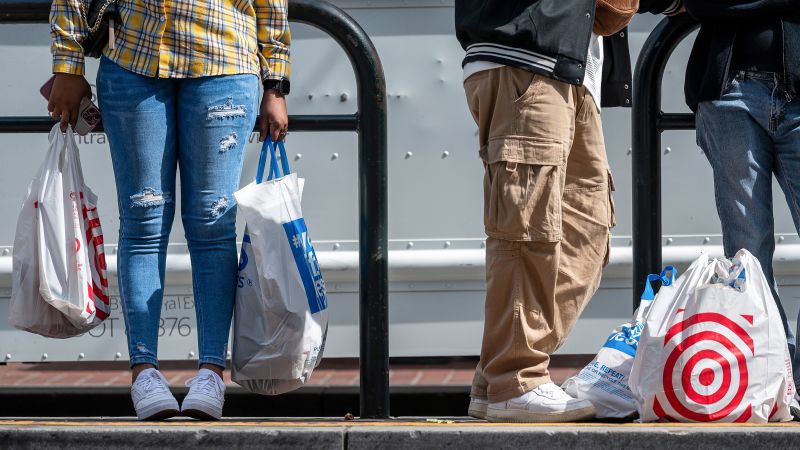Washington
CNN
—
Americans are still dreading a recession and rising inflation, even after President Donald Trump paused his massive tariff hike on dozens of countries.
Consumer sentiment plunged 8% in April from the prior month, to a final reading of 52.2, the University of Michigan said in its latest survey released Friday. That was a slightly smaller decline than a preliminary reading from earlier this month, which didn’t capture people’s reaction to Trump’s 90-day tariff delay announced on April 9.
Sentiment in April was at its fourth-lowest level on records going back to 1952.
“While this month’s deterioration was particularly strong for middle-income families, expectations worsened for vast swaths of the population across age, education, income, and political affiliation,” Joanne Hsu, the survey’s director, said in a release. “Consumers perceived risks to multiple aspects of the economy, in large part due to ongoing uncertainty around trade policy and the potential for a resurgence of inflation looming ahead.”
Stocks briefly jumped off their lows as investors assessed the latest survey: The Dow was down 200 points, or 0.5%. The S&P 500 was down 0.15%. The Nasdaq Composite gained 0.1%.
Trump’s unpredictable trade war has weighed on Americans’ attitudes toward the economy over the past few months, and now the Federal Reserve and Wall Street are watching to see if that means consumers become more cautious with their spending, or even pull back entirely.
Consumer spending powers the vast majority of the US economy, so such a development would inherently mean weaker economic growth or even a recession.
The US consumer is clearly feeling uneasy, but it’s unclear how that will translate into spending.
In June 2022, when inflation reached a four-decade high, consumer sentiment reached a record low, but shoppers continued to spend in the following months. And in 2023, when there was a standoff in Congress over the debt ceiling, Americans’ economic mood soured but they still doled out on travel and concerts that year. Both economic growth and the labor market were on solid ground those years.
“Sometimes the surveys are very negative, but they keep spending,” Fed Chair Jerome Powell said in remarks earlier this month.
However, today’s economy is different from the one in 2022. The job market isn’t running at the same red-hot pace; consumers have already exhausted any savings they accumulated during the pandemic; and just this week, the Department of Education announced it will resume the collection of federal student loans in default, ending a pandemic-era pause that began roughly five years ago.
There’s also evidence that consumers became more financially strained at the end of last year, according to the New York Fed’s latest quarterly survey on household finances.
Economists say it’s been difficult to asses the underlying health of consumer spending because of temporary distortions to economic data, such as people front-running purchases of big-ticket items to beat Trump, tariffs, which sent retail sales surging in March.
But as long as unemployment remains low and layoffs aren’t picking up meaningfully, then spending should continue to chug along.
The lingering uncertainty over Trump’s policies is also bedeviling central bankers who set interest rate policy, affecting the costs on everything from mortgages to credit cards.
Trump’s tariffs are widely expected to boost inflation, but its extent and duration is debated among economists. That’s an important element that Fed officials are considering when considering their next moves once tariffs begin to show up in the data.
“We just don’t know right now with confidence: Is this a one-time effect on inflation, or is it something longer term?” Minneapolis Fed President Neel Kashkari said Tuesday at an event in Washington. “Our job with the Fed is to make sure it is not something longer term.”
One survey-based measure that Fed policymakers care a whole lot about is people’s perception of prices, and that’s because they can be self-fulfilling. If people expect inflation to pick up and remain elevated, then they can adjust their spending accordingly. Inflation expectations in the year ahead for April were slightly lower in the University of Michigan’s final consumer sentiment report compared to the preliminary one, but they still reached their highest level since 1981.
For now, however, Fed officials have adopted a wait-and-see approach to see how the US economy ultimately responds to the administration’s slew of significant policy changes.
Trump’s shock therapy has already shown up in the so-called soft data — surveys such as the University of Michigan consumer sentiment report. But there haven’t been any red flags just yet of Trump’s policies inflicting economic damage according to the “hard data,” which are figures that capture actual economic activity.
Most Fed officials have said they’re keeping a close eye on any potential signs of the economic fallout from Trump’s policies, which, in addition to tariffs, also includes mass deportations and deregulation.
“It is important for monetary policymakers to broadly examine all available information, including market-based measures, surveys and anecdotal reports, to understand what is happening in the economy as early as possible because, as I discussed, it takes time for policy to have an impact,” Fed Governor Adriana Kugler said Tuesday at an event in Minneapolis.

